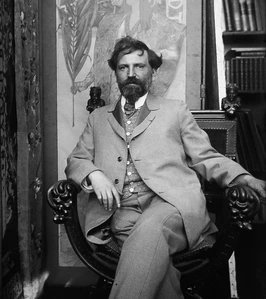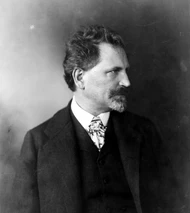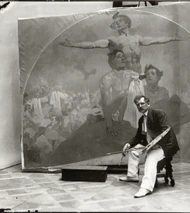


Biography
(1860-1939)
Alfons Mucha
-
1860
Born on July 24 in Ivančice, South Moravia. -
1879
He leaves for Vienna to work as a theater set painter, while also attending evening drawing classes. -
1883
Invited by Count Khuen-Belasi to create decorations for Emmahof Castle. -
1885
Thanks to financial support from Khuen-Belasi, he begins his studies at the Munich Academy of Arts. -
1887
With the continued support of Count Khuen-Belasi, he goes to Paris to study at the Académie Julian. -
1889
In January 1889, the count unexpectedly stopped supporting him. Mucha left school and began to make a living as an illustrator. His work was published in Czech magazines, and after 1890 he began to collaborate with various Parisian magazines and publishers. -
1892
Commissioned with an important order to illustrate Scènes et épisodes de l'histoire d'Allemagne (Scenes and Stories from the History of Germany) by Charles Seignobos. -
1894
He designs his first poster commissioned by Sarah Bernhardt, in the role of Gismonda, in a drama by Victor Sardou. The poster is an immediate sensational success and Mucha signs a six-year contract with "The Divine Sarah". -
1896
Mucha's first decorative panel, The Four Seasons, is printed. -
1897
In February Mucha's first solo exhibition opens at the Bodinière Gallery in Paris, with 107 works on display, followed in May by an exhibition at the Salon des Cent with 448 works. A selection from this exhibition was also on display at the Topič Salon in Prague. -
1899
He accepts the mandate of the Austro-Hungarian government to participate in the World Exhibition in Paris in 1900. -
1900
He begins work on the interior and facade design of the famous Fouquet's jewelry store on Rue Royale in Paris. -
1902
Documents décoratifs, a sample book of decorative motifs and a guide for artists, is published. -
1903
In Paris, he met his future wife, Marie Chytilová, and in Prague, he designed a set for Smetana's opera Libuše for the National Theatre. -
1906
Mucha leaves for America, where he teaches and at the same time paints a number of portraits and advertising commissions. He remains active in the USA until 1910. -
1910
He returns to Bohemia and rents premises at Zbiroh Castle to work on The Slav Epic. He also lives in the east wing of the castle with his family. -
1911
He completes the decoration of the Mayor's Salon of the Prague Municipal House, as the last great work of art in the Art Nouveau style in Prague. -
1918
He designs postage stamps and banknotes for the newly formed Czechoslovak state. -
1921
A hugely popular exhibition of Mucha's works is underway at the Brooklyn Museum in New York. -
1928
Mucha and his family move to a villa in Bubeneč, Prague. 21.9. The complete cycle The Slav Epic is officially presented to the Czech people and the city of Prague. -
1930
He designs a colorful stained glass window for Prague's St. Vitus Cathedral. -
1939
After the German invasion of Czechoslovakia, Mucha was among the first people arrested by the Gestapo for his Masonic activities. He was allowed to return home, but his health deteriorated rapidly and he died in Prague on July 14, 1939. Mucha was buried in the Vyšehrad cemetery. The Parisian graphic magazine Arts et métiers published an issue dedicated to Mucha's memory.